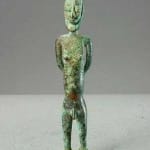Dogon Bronze Figure of a Captive, 1500 CE - 1800 CE
Bronze
8
PF.4881
Further images
For centuries miniature bronze sculptures have been made by blacksmiths for use by individuals as protective charms and commemorative devices. Though they take different forms influenced by various peoples who...
For centuries miniature bronze sculptures have been made by blacksmiths for use by individuals as protective charms and commemorative devices. Though they take different forms influenced by various peoples who journeyed through the Dogon region, at some point a distinctive style emerged, beautifully expressed in this extraordinary figure. Squared shoulders, tapered extremities and stylized facial features are typical of Dogon sculpture in wood or bronze. The angularity the face, with its sharp chin balanced by the conical head ornament and trapezoidal ears, creates a surreal quality without sacrificing the very real human character. Bulging eyes and puckered mouth express fear of the captive, whose hands and feet are bound with twine. The leanness of his torso and limbs is a highly effective artistic style, and also expressive of a prisoner's physical condition. Perhaps a warrior once wore this figure as a symbol of his prowess in battle. Today, this it appears absolutely modern; estraordinarily expressive, powerful and larger than life.





